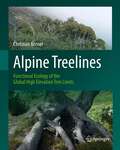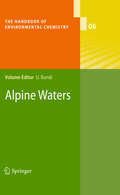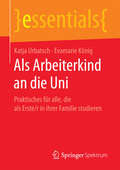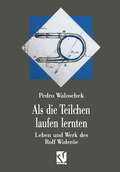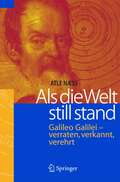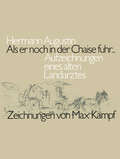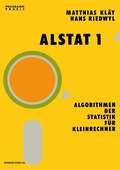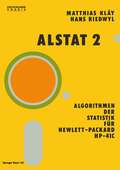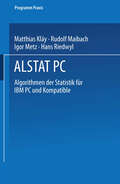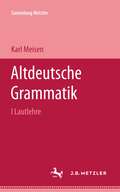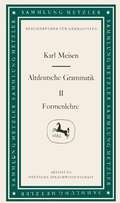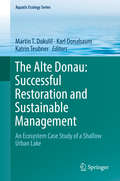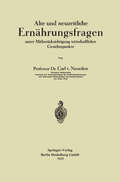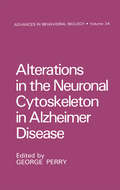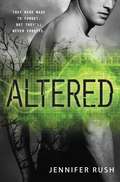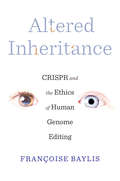- Table View
- List View
Alpine Treelines: Functional Ecology of the Global High Elevation Tree Limits
by Christian KörnerAlpine treelines mark the low-temperature limit of tree growth and occur in mountains world-wide. Presenting a companion to his book Alpine Plant Life, Christian Körner provides a global synthesis of the treeline phenomenon from sub-arctic to equatorial latitudes and a functional explanation based on the biology of trees. The comprehensive text approaches the subject in a multi-disciplinary way by exploring forest patterns at the edge of tree life, tree morphology, anatomy, climatology and, based on this, modelling treeline position, describing reproduction and population processes, development, phenology, evolutionary aspects, as well as summarizing evidence on the physiology of carbon, water and nutrient relations, and stress physiology. It closes with an account on treelines in the past (palaeo-ecology) and a section on global change effects on treelines, now and in the future. With more than 100 illustrations, many of them in colour, the book shows alpine treelines from around the globe and offers a wealth of scientific information in the form of diagrams and tables.
Alpine Waters (The Handbook of Environmental Chemistry #6)
by Armin Peter Christopher T. Robinson Bruno Schädler Bernhard Truffer Stefan Vollenweider Bernhard Wehrli Rolf WeingartnerMost of the world’s mountains are rich in water and, as such, play a pivotal role in the global water cycle. They provide water for diverse human uses and ecosystems. Growing water demands as well as climate change will lead to ever-increasing pressure on mountain waters. Overcoming water-use conflicts and maintaining the ecological functioning of mountain waters presents a highly challenging task and is indispensable for sustainable development.This book extensively portrays the highly diverse attributes of mountain waters and demonstrates their paramount importance for ecological and societal development. The extensive summaries on the scientific basics of mountain waters are supplemented with considerations on the diverse water uses, needs for management actions, and challenges regarding sustainable water management. This overview concerns not only the mountain areas themselves but also downriver reaches and their surrounding lowlands, and, therefore, the relationship between mountain and lowland water issues.
Als Arbeiterkind an die Uni: Praktisches für alle, die als Erste/r in ihrer Familie studieren (essentials)
by Katja Urbatsch Evamarie KönigKatja Urbatsch und Evamarie König liefern in diesem essential praktische Informationen für diejenigen, die darüber nachdenken, als Erste in ihrer Familie zu studieren, oder bereits mit dem Studium begonnen haben. Sie erläutern die typischen Herausforderungen für Studierende der ersten Generation und zeigen Unterstützungsmöglichkeiten und Lösungswege auf. Mit der gemeinnützigen Organisation ArbeiterKind.de begleiten die Autorinnen beruflich Schülerinnen und Schüler sowie Studierende aus Familien ohne Hochschulerfahrung. Daher kennen sie die typischen Fragen und Sorgen, die von Leistungsanforderungen über Studienfinanzierung bis hin zu Berufsperspektiven reichen.
Als die Teilchen laufen lernten (pdf): Leben und Werk des Großvaters der modernen Teilchenbeschleuniger — Rolf Wideröe
by Pedro WaloschekAls die Welt still stand: Galileo Galilei - verraten, verkannt, verehrt
by Atle NaessDie preisgekrönte Biographie des norwegische Schriftstellers Atle Næss führt den Leser auf eine fesselnde Reise durch die Höhen und Tiefen des Lebens einer der schillerndsten Persönlichkeiten der europäischen Wissenschaftsgeschichte - Galileo Galilei. Mit feinsinniger Empathie entwickelt Naess das Portrait eines Mannes, der sich selbst durch die Zwänge der römischen Inquisition nicht von seinen wegweisenden Forschungen abbringen ließ. Aus den Rezensionen der norwegischen Ausgabe: "Mit umfassender Kenntnis und sicherem Erzählstil hebt Næss die epochemachenden Arbeiten hervor, die die Grundlage der modernen experimentellen Naturwissenschaften bilden. Er packt all die vielen Stationen [Galileis] Lebens in ein sehr lesenswertes Buch, das in vielerlei Hinsicht hervorsticht." Per Anders Madsen, Aftenposten Morgen "Diese Biographie stellt eine faszinierende kulturhistorische Studie dar und ist daher nicht nur für Leser mit Interesse an Naturwissenschaft und Wissenschaftsgeschichte geeignet. Sie kann auch hervorragend als Roman gelesen werden." Atle Abelsen, Teknisk Ukeblad
Alstat 2 Algorithmen der Statistik für Hewlett-Packard HP-41C (Programm Praxis #2)
by Kläy Riedwl7 0 INHALT EINLEITUNG 9 1 2 ALLGEMEINER AUFBAU 11 2.1 TECHNISCHE VORAUSSETZUNGEN 11 2.2 GEMEINSAME STRUKTUR DER PROGRAMME 11 11 2.2.1 Aufbau des Tastenfe1des 2.2.2 Grundrechner-Funktionen 17 2.2.3 Kontro11funktionen 18 21 2.2.4 Eingabefunktionen . 2.2.5 Variab1en . 21 21 2.2.6 Statistikfunktionen 2.3 FEHLERBEHANDLUNG 22 23 2.4 DIE TRANSFORMATIONSROUTINE TRA 24 2.5 FORMAT DER FUNKTIONSBESCHREIBUNGEN 2.6 ZU DEN BEISPIELEN . 25 26 3 STAT1 PROGRAMMBESCHREIBUNG 3.1 DAS TASTENFELD 26 29 3.2 FUNKTIONSBESCHREIBUNGEN . 3.2.1 Kontro11funktionen 29 30 3.2.2 Eingabefunktionen . 3.2.3 Variab1en . 32 3.2.4 Statistikfunktionen 33 3.3 BEMERKUNGEN . 35 3.3.1 Masszah1en 35 3.3.2 Extremwerte . 35 3.3.3 Der Stack. 36 3.3.4 Transformationen 36 36 3.3.5 Histogramm 3.3.6 Hinweis zum a11gemeinen Gebrauch 37 3.4 FEHLERLISTE . 38 3.5 BEISPIELE . 39 LINMOD PROGRAMMBESCHREIBUNG . 51 4 4.1 DAS TASTENFELD 51 4.2 FUNKTIONSBESCHREIBUNGEN . 54 4.2.1 Kontro11funktionen 54 54 4.2.2 Eingabefunktionen . 4.2.3 Variab1en . 56 4.2.4 Statistikfunktionen 56 59 4.3 BEMERKUNGEN .
ALSTAT PC: Algorithmen der Statistik für IBM PC und Kompatible (Programm Praxis #7)
by Kläy Maibach Metz RiedwylThe Alte Donau: An Ecosystem Case Study of a Shallow Urban Lake (Aquatic Ecology Series #10)
by Martin T. Dokulil Karl Donabaum Katrin TeubnerHere we report on a 25-year long-term sequence of measures to return a deteriorated recreational urban lake, Alte Donau in Vienna to acceptable water quality. Metropolitan waters require focused ecosystem management plans and intensive in-lake efforts. We explored physico-chemical conditions, food web from viruses to fish and water birds, the sediments, the littoral zone and the catchment, management and urban planning, and global warming. Several restoration techniques were tested and critically evaluated. The final management plan was based on bi-stable theory. During the recovery phase, numerous surplus adjustments had to be implemented to secure sustainable achievement.
Alte und neuzeitliche Ernährungsfragen: unter Mitberücksichtigung wirtschaftlicher Gesichtspunkte
by Carl von NoordenDieser Buchtitel ist Teil des Digitalisierungsprojekts Springer Book Archives mit Publikationen, die seit den Anfängen des Verlags von 1842 erschienen sind. Der Verlag stellt mit diesem Archiv Quellen für die historische wie auch die disziplingeschichtliche Forschung zur Verfügung, die jeweils im historischen Kontext betrachtet werden müssen. Dieser Titel erschien in der Zeit vor 1945 und wird daher in seiner zeittypischen politisch-ideologischen Ausrichtung vom Verlag nicht beworben.
Alterations in the Neuronal Cytoskeleton in Alzheimer Disease (Advances in Behavioral Biology #34)
by George PerryThe neuronal cytoskeleton is a complex structure responsive to both intrinsic and extrinsic factors. Defined populations of neurons in the brains of patients with Alzheimer and several other neurodegenerative diseases contain abnormal filamentous accumulations which share elements with the cytoskeleton. Although there is a general consensus that these abnormal filaments do contain cytoskeletal elements, much debate remains regarding which cytoskeletal elements are incorporated and whether the cytoskeletal rearrangement is primary or secondary to other cellular changes. In this book these questions are addressed in a historical perspect ive in light of new data that allows the reinterpretation of previously reported results. Contributions are based on many of the major tech niques of modern biology including biochemistry, molecular biology, electron microscopy and immunocytochemistry. In the view of the editor, this volume is being written at a time when our understanding of the cytopathology of Alzheimer disease is moving from predominantly descriptive to both analytical and mechanistic. I hope that this contribution will provide impetus to speed this transi tion. George Perry Cleveland, Ohio vii ACKNOWLEDGEMENT The support of the Fidia Pharmaceutic Corporation for the computer generated color figure on page 65 is gratefully acknowledged.
Altered: An Altered Saga Novella (Altered #1)
by Jennifer RushThey were made to forget. But they'll never forgive.Everything about Anna's life is a secret. Her father works for the Branch, at the helm of its latest project: monitoring and administering treatments to the four genetically altered boys in the lab below their farmhouse. There's Nick, solemn and brooding; Cas, light-hearted and playful; Trev, smart and caring; and Sam . . . who's stolen Anna's heart.When the Branch decides it's time to take the boys, Sam stages an escape. Anna's father pushes her to go with them, making Sam promise to keep her away from the Branch, at all costs. On the run, with her father's warning in her head, Anna begins to doubt everything she thought she knew about herself. She soon discovers that she and Sam are connected in more ways than either of them expected. And if they're both going to survive, they must piece together the clues of their past before the Branch catches up to them and steals it all away.
Altered Inheritance: CRISPR and the Ethics of Human Genome Editing
by Françoise BaylisWith the advent of CRISPR gene-editing technology, designer babies have become a reality. Françoise Baylis insists that scientists alone cannot decide the terms of this new era in human evolution. Members of the public, with diverse interests and perspectives, must have a role in determining our future as a species.
Altered Sensations: Rudolph Koenig’s Acoustical Workshop in Nineteenth-Century Paris (Archimedes #24)
by David PantalonyRudolph Koenig was one of the more prolific and colourful instrument makers in the renowned nineteenth-century precision instrument trade of Paris. Beginning his career as a violin maker, in 1858 the young Prussian immigrant shifted his talents towards the growing field of acoustics. Altered Sensations is a portrait of his vibrant atelier, a place of construction, commerce and experiment. For over forty years it was also a popular meeting place for scientists, artisans, musicians and teachers. Using archival and collection research from across North American and Europe, David Pantalony has traced the material and social influences of this space on the development of modern acoustics. In particular, he has detailed the manner in which Koenig modified, extended, spread and challenged Hermann von Helmholtz's Sensations of Tone. A large part of the research on Koenig comes from the actual products of his workshop which survive in museums and collections around the world. The second section of Altered Sensations provides a Catalogue Raisonné of Koenig’s entire line of instruments, including their history, details from specific examples, locations, and references in the literature. This catalogue will serve as a practical guide for curators and researchers as well as a comprehensive overview of nineteenth-century acoustical practice.
Altering Nature: Volume II: Religion, Biotechnology, and Public Policy (Philosophy and Medicine #98)
by Gerald P. McKenny B. A. Lustig B. A. BrodyB. Andrew Lustig, Baruch A. Brody, and Gerald P. McKenny In this second volume of the “Altering Nature” project, we situate specific religious and policy discussions of four broad areas of biotechnology within the context of our interdisciplinary research on concepts of nature and the natural in the first volume (Altering Nature, Concepts of Nature and the Natural in Biotechnology Debates). In the first volume, we invited five groups of scholars to explore the diverse conc- tions of nature and the natural that shape moral judgments about human alterations of nature, as especially exemplified by recent developments in biotechnology. A careful reading of such developments reveals that assessments of them—whether positive or negative—are often informed by different conceptual interpretations of nature and the natural, with differing implications for judgments about the app- priateness of particular alterations of nature. These varying interpretations of nature and the natural often result from the distinctive perspectives that characterize va- ous scholarly disciplines. Therefore, in an effort to explore the variety of meanings that attend discussions of the concepts of nature and the natural, the contributors to the first volume of Altering Nature addressed those concepts from five different disciplinary vantages. A first group of scholars analyzed a range of religious and spiritual perspectives on concepts of nature and the natural. Their research highlighted the thematic, h- torical, and methodological touchstones in those traditions that shape their persp- tives on nature.
Altering Nature: Volume I: Concepts of ‘Nature’ and ‘The Natural’ in Biotechnology Debates (Philosophy and Medicine #97)
by Gerald P. McKenny B. A. Lustig B. A. BrodyB. Andrew Lustig, Baruch A. Brody, and Gerald P. McKenny Nearly every week the general public is treated to an announcement of another actual or potential “breakthrough” in biotechnology. Headlines trumpet advances in assisted reproduction, current or prospective experiments in cloning, and devel- ments in regenerative medicine, stem cell technologies, and tissue engineering. Scientific and popular accounts explore the perils and the possibilities of enhancing human capacities by computer-based, biomolecular, or mechanical means through advances in artificial intelligence, genetics, and nanotechnology. Reports abound concerning ever more sophisticated genetic techniques being introduced into ag- culture and animal husbandry, as well as efforts to enhance and protect biodiversity. Given the pace of such developments, many insightful commentators have proclaimed the 21st century as the “biotechnology century. ” Despite a significant literature on the morality of these particular advances in biotechnology, deeper ethical analysis has often been lacking. Our preliminary review of that literature suggested that current discussions of normative issues in biotechnology have suffered from two major deficiencies. First, the discussions have been too often piecemeal in character, limited to after-the-fact analyses of particular issues that provoked the debate, and unconnected to larger concepts and themes. Second, a crucial missing element of those discussions has been the failure to reflect explicitly on the diverse disciplinary conceptions of nature and the natural that shape moral judgments about the legitimacy of specific forms of research and their applications.
Altern: Alter und Altern individuell, kollektiv und die Folgen (Schriften der Mathematisch-naturwissenschaftlichen Klasse #27)
by Heinz Häfner Thomas W. Holstein Anthony D. HoWir haben immer mehr Alte, immer weniger Kinder. Dank wissenschaftlicher Fortschritte verlängert sich die Lebenserwartung ständig. Erkenntnisse aus der Naturwissenschaft in der post-genomischen Ära deuten darauf, dass diese Entwicklung trotz der Zunahme altersassoziierter Krankheiten und Behinderungen noch nicht am Ende angekommen ist. Droht diese Flut von Alten, Rentnern und „Konsumenten des Lebens“ zum Verlust des Zusammenhalts der Gesellschaft zu führen? Nach der Bestandsaufnahme der jüngsten Errungenschaften der Forschung hat das interaktive Symposium sich mit den Chancen und Gefahren der „gewonnenen Jahre“ auseinandergesetzt. Die Referentinnen und Referenten sind herausragende Vertreter der Biologie und Medizin. Meinungsbildner der Geisteswissenschaften und Persönlichkeiten aus der Politik kamen ebenfalls zu Wort.
Altern: Zelluläre und molekulare Grundlagen, körperliche Veränderungen und Erkrankungen, Therapieansätze
by Ludger Rensing Volkhard RippeDas für ein breites Publikum geschriebene Werk zeigt die kausalen Verbindungen zwischen den messbaren Alterserscheinungen und den zugrundeliegenden Veränderungen in Genen, Zellen und in deren Kommunikationssystemen auf. Molekularbiologische Ansätze gewinnen in Medizin und Pharmakologie immer mehr an Bedeutung (Molekulare Medizin, targeted therapies, genombasierte personalisierte Medizin), und Kenntnisse über kausale Mechanismen der Alterung werden die Vorsorge und Therapie zahlreicher Alterskrankheiten deutlich verbessern können. Die Autoren erläutern diese Zusammenhänge an elf menschlichen Funktionssystemen: Haut, Knochenskelett, Muskulatur, Kreislauf und Lunge, Immunsystem, Verdauungssystem, Ausscheidungssystem, Sexualität und Fortpflanzung, Hormonsystem, zentrales Nervensystem und Sinnesorgane. Jedes Kapitel beginnt mit einer kurzen Übersicht über die normalen Funktionen des Systems; dann werden die altersabhängigen Veränderungen und Erkrankungen mit den zugrundeliegenden molekularen Mechanismen dargestellt. Abschließend gehen die Autoren auf einige medizinische Aspekte von Alterserkrankungen und wichtige therapeutische Ansätze ein. Am Anfang des Buches steht ein einführendes Kapitel über die grundlegenden (evolutions)biologischen Fragen zu Alterungsvorgängen, gefolgt von einer Übersicht über den gegenwärtigen Stand der Altersforschung und die wichtigsten Alterstheorien, darunter die Theorie der Schadensakkumulation und die Theorie der Verkürzung der Chromosomenenden (Telomere). Im letzten Kapitel des Werkes geht es schließlich um die Frage, wodurch die Korrelation zwischen Alter und dem Auftreten der meisten Krebstypen zustande kommt und welche äußeren und inneren Faktoren dabei mitwirken.
Alternaria Diseases of Crucifers: Biology, Ecology and Disease Management
by Gobind Singh Saharan Naresh Mehta Prabhu Dayal MeenaThis book deals with the various aspects viz., the disease, geographical distribution, symptoms on different hosts, host range, yield losses, and disease assessment method, while detailed description on pathogen include taxonomic position, phylogeny, variability, sporulation, perpetuation, and spore germination, host-parasite interactions in the form of seed infection, disease cycle, process of infection, and pathogenesis, epidemiology, forecasting, fine structures, biochemical changes, and phytotoxins, host defence mechanism, techniques to study host-parasite relationships, and management practices including cultural, chemical, biological control practices, and deployment of host resistance. The last section deals with gaps in our understanding, and knowledge about management of these diseases, techniques for the diagnosis of disease and offer suggestions for future research priorities. Each aspect has been vividly illustrated with photographs, histograms, figures, tables, electron micrographs for stimulating, effective and easy reading and understanding. We are sure that this comprehensive encyclopaedic treatise on "Alternaria diseases of crucifers” will be of immense use to the researchers, teachers, students and all others who are interested in the diagnosis and management of Alternaria diseases of crucifers world over. Four species of Alternaria are wide spread and most devastating on cruciferous oil yielding crops, vegetables, forage crops, ornamental plants, and numerous weeds all over the world. The damage to the plants is in the form of infections on seed in the soil during sowing, on seedlings during emergence and growth, on stem, leaves, inflorescence, pods and finally to the seed causing yield losses in seed quantity and quality.
Alternate Light Source Imaging: Forensic Photography Techniques
by Norman Marin Jeffrey BuszkaAlternate Light Source Imaging provides a brief guide to digital imaging using reflected infrared and ultraviolet radiation for crime scene photographers. Clear and concise instruction illustrates how to accomplish good photographs in a variety of forensic situations. It demonstrates how tunable wavelength light sources and digital imaging techniques can be used to successfully locate and document physical evidence at the crime scene, in the morgue, or in the laboratory. The scientific principles that make this type of photography possible are described, followed by the basic steps that can be utilized to capture high quality evidentiary photographs.
Alternate Light Source Imaging: Forensic Photography Techniques
by Norman Marin Jeffrey BuszkaAlternate Light Source Imaging provides a brief guide to digital imaging using reflected infrared and ultraviolet radiation for crime scene photographers. Clear and concise instruction illustrates how to accomplish good photographs in a variety of forensic situations. It demonstrates how tunable wavelength light sources and digital imaging techniques can be used to successfully locate and document physical evidence at the crime scene, in the morgue, or in the laboratory. The scientific principles that make this type of photography possible are described, followed by the basic steps that can be utilized to capture high quality evidentiary photographs.
